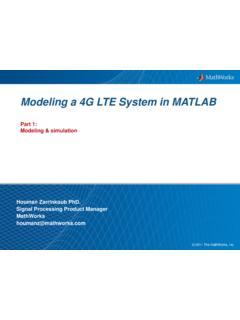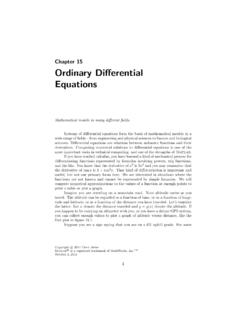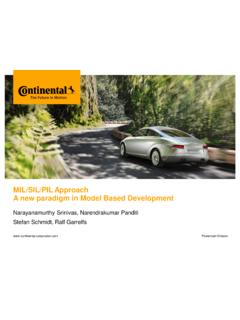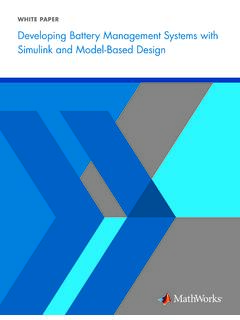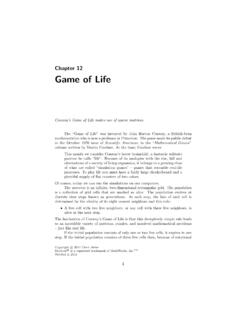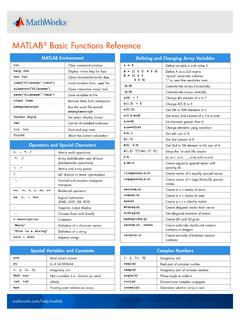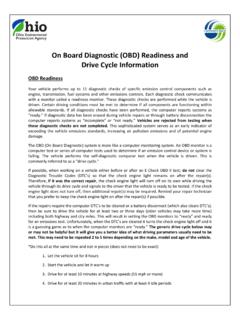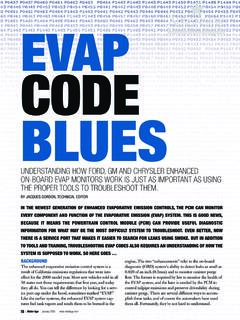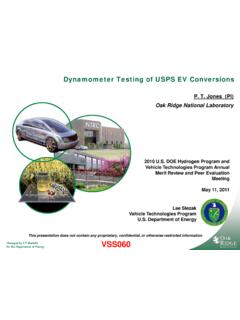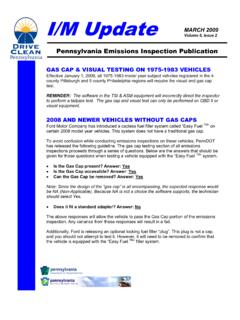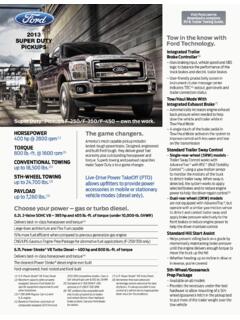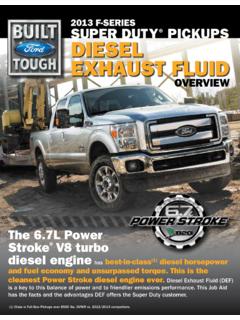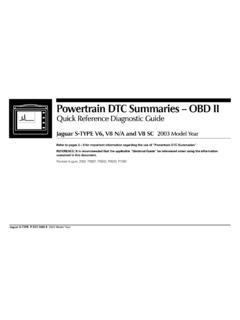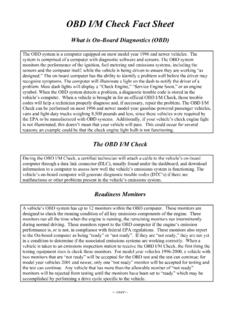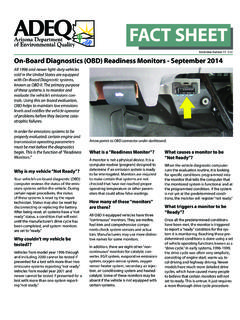Transcription of Using Model-Based Calibration Toolbox Multimodels for ...
1 Using Model-Based Calibration Toolbox Multimodels for cycle -Optimized Diesel Calibration Joshua P. Styron ford Motor Company ABSTRACT Modern diesel engines have many degrees of freedom that must be simultaneously adjusted to optimize efficiency, emissions, and performance. Model-Based Calibration ToolboxTM from The MathWorks has been used to fully optimize a base-engine Calibration to meet cycle - based emissions and fuel economy targets as well as local combustion noise targets and mechanical limits. Multimodels were used to build a collection of local models that behave as global models at the discrete speed/load test points. This facilitates the use of sum constraints to represent drive cycles and gradient constraints to ensure smooth Calibration tables. INTRODUCTION Modern diesel engines have many degrees of freedom that must be simultaneously adjusted to optimize efficiency, emissions, and performance.
2 Due to the complexity of the interactions among the input parameters, it is not possible to decompose the Calibration process into a set of smaller, simpler models. To meet drive- cycle emissions and fuel economy targets, tradeoffs must be made among various speeds and loads. Therefore, the drive- cycle -optimized solution is not the same as a collection of individually optimized speed and load operating conditions. To project cycle - based emissions and fuel consumption, engine responses must be modeled at a number of speed/load operating conditions and integrated with appropriate weighting factors at each speed/load. Simply expanding local models by adding the two inputs to represent speed and load may result in a loss of fidelity as the models become too complex. A new global model type was needed to maintain maximum local model quality while allowing cycle - based tradeoffs to be assessed.
3 Multimodels were introduced in Model-Based Calibration Toolbox to address this need. Multimodels essentially select the best local model at each speed and load operating point. These global models retain all of the fidelity of the local models, while allowing tradeoffs among discrete speed and load points in cycle optimizations. In the Calibration Generation (CAGE) tool, Multimodels were used to generate steady-state Calibration set points for an entire engine map that minimize fuel consumption while simultaneously meeting cycle emissions and local NVH targets. In addition, many constraints were utilized to ensure the Calibration was realistic. Map gradient constraints helped to ensure the resulting optimized maps would be smooth enough. Boundary constraints were used to limit the optimization to attainable points, while models of critical engine limits such as peak cylinder pressure and turbine inlet temperature ensure the Calibration remains within the critical engine limits.
4 OVERVIEW OF Calibration PROCESS STEPS This paper explores the essential steps required to generate a steady-state, base-engine diesel Calibration . After this brief overview, each step is described in more detail. Generic Calibration Steps: 1. Identify designed experiment (DoE) speed/load operating points and weighting factors. a. Select load axis for experiments. b. Cascade all relevant vehicle drive cycles to engine speed/load operating points. c. Select speed/load break points for DoE. d. Calculate time weights for each DoE speed/load point over each drive cycle . 2. Determine DoE factors and bounds for each DoE speed/load point. a. Identify Calibration factors to be varied. b. Select appropriate ranges for each factor at each speed/load point. c. Select size of DoE runs depending on model complexity.
5 3. Collect and prepare data for Model-Based Calibration Toolbox . 4. Build Multimodels of engine responses and boundary models. 5. Optimize Calibration . a. Optimize each speed/load independently for fuel economy, respecting independent constraints (noise, smoke, hydrocarbon emissions, combustion stability, and mechanical limits). b. Optimize set of speed/load points collectively for cycle fuel economy while meeting cycle emissions and map gradient constraints in addition to independent constraints. 6. Export Calibration tables and verify engine responses. DEFINE SPEED AND LOAD OPERATING POINTS Depending on the engine certification path, this step may be predefined. For instance, dynamometer-certified engines certify emissions compliance with test cycles that depend on the maximum torque capability of the engine as a function of speed.
6 For chassis-certified engines, however, this step is significantly more challenging. The certification requirements are defined at the vehicle level rather than at the engine level, so more information is needed to determine the corresponding engine operating conditions. Early in vehicle programs, this additional information required to determine the engine speed/load over the vehicle drive cycles is likely to come from detailed vehicle simulations. However, it could also come from actual vehicle tests. In either case, the real or virtual vehicle must be "driven" over all of the important drive cycles and engine speed/load must be recorded as a function of time. SELECT LOAD AXIS Engine load can be measured in many ways. Injected fuel quantity, percent of peak torque, brake torque, net indicated torque, and gross indicated torque are all acceptable measures of engine load.
7 The choice of load axis influences the results of the mapping process and can introduce unexpected errors at different places in the process. The two items influencing the choice of load axis are the software strategy used to control the engine and the certification process. The choice of load axis affects test bed operation, optimization accuracy, and Calibration table filling accuracy. If the control strategy is defined in brake torque, the choice of DoE load axis is straightforward. If the control strategy is based on gross indicated torque, the choice becomes more complicated. Gross indicated torque is the torque the engine would generate over the compression and expansion strokes with no frictional losses. Sometimes gross indicated torque is referred to as inner torque as it is the work extracted from the gases inside the engine.
8 Consider this latter scenario where the control strategy is defined in gross indicated torque, and brake torque is chosen as the load axis. Holding brake torque constant during DoE testing is straightforward with the use of a closed-loop controller on dynamometer-measured torque. Because the drive- cycle load axis and the DoE load axis match, time weight factors can be applied directly. No additional errors are introduced during this optimization step as a result. The only issue with choosing brake torque as the load axis comes when actual Calibration tables need to be filled. Because the load axes don t match, an interpolation routine must be used to convert from one load unit to the other. For revisiting DoE results when later investigating tradeoffs, great care must be exercised to ensure the friction of the engine hasn't changed.
9 A fresh map of break torque to gross indicated torque may need to be used to determine which DoE results apply to a given operating condition. If gross indicated torque is chosen as the load axis, then interpolation errors are introduced at a different step in the process. The main advantage of working with the same load axis as the control strategy is in the simplicity of Calibration table filling. The DoE results can be directly applied to the Calibration tables. Further, indentifying which DoEs apply to a given Calibration issue is straightforward. For example, if an issue is discovered in vehicle testing, brake torque as measured on the engine dynamometer is not likely to be available. Care must be exercised when applying time weights that were derived based on brake torque to DoE points taken at constant gross indicated torque.
10 Mass flow engine responses that are used for cycle emissions and fuel economy assessments should be divided by the ratio of actual brake torque to the brake torque assumed when the time weights were calculated. Errors associated with this adjustment depend on how close the baseline engine map is to the final engine map. If some DoE points are below or near zero torque, this correction can lead to large errors. Therefore, mass-flow parameters near or below zero torque should not be adjusted. Considering the overall goal of minimum model error, the choice of load axis still depends on the details of a given engine program. For a dynamometer-certified engine, having DoE models that match the heavily-weighted, regulated speed/load points offers advantages when trying to optimize the Calibration for the regulated cycle .
